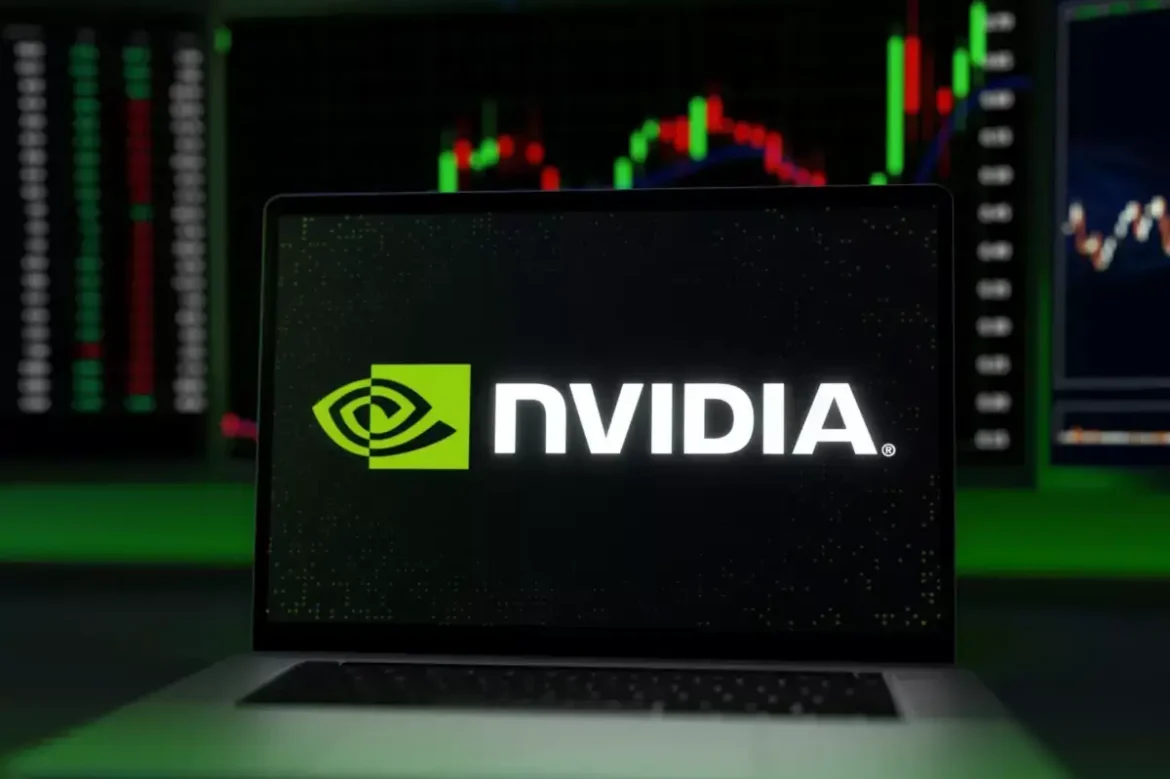Nvidia (nvda) riding the crest of a wave in the tech industry.
Something rather special happened on the world’s stock markets a few days ago. A company called Nvidia (NVDA) overtook Apple (AAPL) to become the world’s second-most valuable company after achieving a $3 trillion (£2.4 trillion) valuation. In first place at the time was Microsoft (MSFT) with a valuation of $3.15 trillion. As of the time of writing, Apple has now regained the number two spot, with Nvidia falling off a bit and going back down to a mere $2.97 trillion. This has probably been due to some profit taking by certain stockholders, namely those who reckoned that the high valuation gave them an opportunity to cash out their profits. There might also have been some who thought that number two place was a bit hyped and would not last. In having a mini sell-off they then proceeded to fulfil their own estimations.
However, there are several remarkable things to consider regarding this huge Nvidia valuation. The first is that while everyone has heard of Microsoft and Apple, and everyone has also heard of Alphabet-Google (GOOG) and Amazon (AMZN) who are in fourth place and fifth place respectively, comparatively few outside the Information Technology (IT) field or the stock market had even heard of Nvidia until recently.
But such is the power and thrust of IT companies with the next great idea, that once that company with that next great idea has been identified, the sky would appear to be the limit. And in this case, Nvidia’s idea is its artificial intelligence (AI) processors, which are key to systems such as ChatGPT and all its various imitators, such as Google Gemini (previously Bard), Writesonic, Spinbot, Jasper Chat and all the others. Since AI is seen as the future of IT, and to hear some analysts talk, perhaps the future of everything, then possessing the leading technology to enable it to happen is the 21st Century’s holy grail and mother lode all wrapped into one.
So, who are or what is Nvidia, this company which ostensibly holds the key to the future? Nvidia Corporation is an American multinational corporation and technology company headquartered in Santa Clara, California. However, at the same time the incorporation is in Delaware, presumably for the state’s favourable tax regime.
Concerning its functions, it is a software and fabless company which in addition to the AI processors, designs and supplies graphics processing units (GPUs), application programming interfaces (APIs), as well as system on a chip units (SoCs) for the mobile computing and the automotive market.
And now Nvidia is one of the highest valued companies on the stock market. Essentially it is one of the big boys, one of the high rollers, the crème of the stock market crème. Nvidia’s shares have climbed by more than 150 percent in 2024 alone, and they are up by more than 600 percent since November 2022, which was when ChatGPT was released and first came to general attention. At the time, some analysts were more impressed with ChatGPT than others, with some dismissing its abilities to write poetry, whereas others had noted its abilities to write school essays and even to answer examination papers.
But this was new territory, with ChatGPT being the first to boldly go where no other software had gone before. In this regard, one could say that Microsoft had its own Star Tech. However, at the time it was released, the end user could only judge ChatGPT itself. That was all the users saw and that was all they could use. So, if Microsoft set up ChatGPT to perform with a certain cultural bias, shall we say, and some analysts said they were able to detect this bias, then that was on the way Microsoft had set it up. The point here is that any such bias was not informing anyone about AI and its full potential using these Nvidia processor chips. Therefore, it is quite possible that ChatGPT’s clunky performance concerning cultural bias was obscuring, to some extent, what a fully liberated AI industry would be capable of. We can look in several different areas to see what AI could achieve one day.
For example, in a manufacturing plant, AI is of great use in proactive and predictive maintenance. AI can be used to monitor and analyse data from machinery and shop floor processes so that manufacturers can identify anomalous patterns to predict or even prevent breakdowns. For example, AI can process machine vibration, thermal imaging and oil analysis data to assess the health of any piece of machinery. The insights from AI also enable manufacturers to order in spare parts and consumables correctly and accurately predict the downtime that will affect production planning and related activities. The result is an improvement in productivity, cost efficiency and equipment health. Generative AI can add further value by scanning documents, such as maintenance logs and inspection manuals to provide actionable, precise information to enable troubleshooting and the provision of timely maintenance.
Looking at another example, this time in the military, we can see how the Israeli Defence Force (IDF) has used AI capability in the design of its new Barak battle tank. One of its stand-up features is its AI power targeting system allowing it to monitor its surroundings and quickly identify and engage enemy forces before they can pose a threat. Inside the tank, crew members benefit from the remarkable vision helmet which enables them to see through the vehicle’s armour, thus overcoming visibility limitations and enhancing mission efficiency and safety. This helmet provides a 360-degree view and utilizes AI for real-time target tracking.
The thought of autonomous tanks trundling around a battlefield being guided by AI might make some people hesitate. Their thinking might well be, “Well what if it goes rogue and we cannot control where it goes or what it does?” That is certainly worth thinking about. But maybe one of the remarkable issues about AI is not that it might do something badly or inaccurately, but rather that it can do these things at all.
And the fact that AI can indeed do those kinds of things is the main reason that Nvidia is the toast of the stock market. While Nvidia’s market value was taking it past that of Apple, that same $3 trillion market value exceeded the entire combined value of the British FTSE 100, which is the index of the London Stock Exchange’s 100 most valuable companies. To be honest, it is a little difficult to even appreciate what $3 trillion looks like. Most of us are just not used to dealing with such amounts.
No doubt the value of Nvidia will both rise and fall in the future. Such is the nature of individual stocks. In recent times the company’s share price climbed by almost 30 percent in two weeks alone, driven by a sevenfold increase in its quarterly profits and by plans for a stock split, which was to divide its existing shares up by a ratio of ten-to-one. Stock splits are seen as raising investor demand because they make it less expensive to buy individual shares in a company. Before the split, Nvidia’s shares were worth $1,224 each. Now, at the time of writing, and after that ten-to-one split, they are trading at just under $121. So, while the overall value is comparable, it would now be easier to find the capital required to invest.
However, stock split or no stock split, the most important fact is that Nvidia’s value is backed up by the solid fundamentals of AI processing. For now, it has developed a virtual monopoly of one of the most important and sought-after products of this century. The demand is already sky-high, but as society looks to automate more and more functions in almost every field, this can only mean that manufacturers will be looking for ever greater amounts of processing power which they can rely upon to give them greater amounts of machine-based learning. For example, at present, only Tesla has made any progress with self-driving cars, and their performance has certainly not been flawless, but let us imagine what will happen if AI can one day make the self-driving car competent and safe. For it is the AI which can do this, rather than the auto-engineering.
This AI boom has made Jensen Huang, Nvidia’s Taiwanese-born founder and chief executive, one of the world’s wealthiest men. His net worth has soared from $13.8 billion at the start of 2023 to no less than $107 billion today, putting him 13th in Bloomberg’s billionaires’ index. Frankly, he is probably not bothered very much by that huge figure. The point here being, “Who needs $107 billion? In fact, could one even spend $1 billion in a lifetime, even if one worked on it 24/7 and did nothing else?”
However, what surely will give great pleasure to Jensen Huang is the progress made by his company. Nvidia’s GPUs were originally designed for video games but have proven to be critical to AI applications. As a result, the world is beating a constant path to Nvidia’s door, and the company has emerged into its new and powerful position, having come up seemingly overnight and seemingly from nowhere.
Essentially, for now, the company has the AI processing technology which everyone will need as it will be a key component of future industrial development. We can confidently say that the next big IT company has arrived. Will this success last? For now, at least, we don’t know. However, let’s just look at all the companies including Meta, Microsoft and many in the automobile industry who are spending billions on Nvidia GPUs, which are seen as the clear market leader in a vital technology for the future. `);
} else {
$(‘.blur’).css({
‘background’: ‘linear-gradient(95deg, #4e4e4e 25%, #000 45%, #bbb 75%, #FFFFFF 100%) 98%/200% 100%’,
‘text-transform’: ‘inherit’,
‘-webkit-background-clip’: ‘text’,
‘background-clip’: ‘text’,
‘-webkit-text-fill-color’: ‘transparent’
})
$(“.wpb_content_element”).append(`
Want to read more?
Click on the button below to access all premium content
articles by purchasing one of our educational packages
GET PREMIUM
`)
}
});
} else {
$(‘.blur’).css({
‘background’: ‘linear-gradient(95deg, #4e4e4e 25%, #000 45%, #bbb 75%, #FFFFFF 100%) 98%/200% 100%’,
‘text-transform’: ‘inherit’,
‘-webkit-background-clip’: ‘text’,
‘background-clip’: ‘text’,
‘-webkit-text-fill-color’: ‘transparent’
})
$(“.wpb_content_element”).append(`
Want to read more?
Click on the button below to access all premium content
articles by purchasing one of our educational packages
GET PREMIUM
`)
}
});
The post Nvidia (nvda) riding the crest of a wave in the tech industry. appeared first on FinanceBrokerage.

